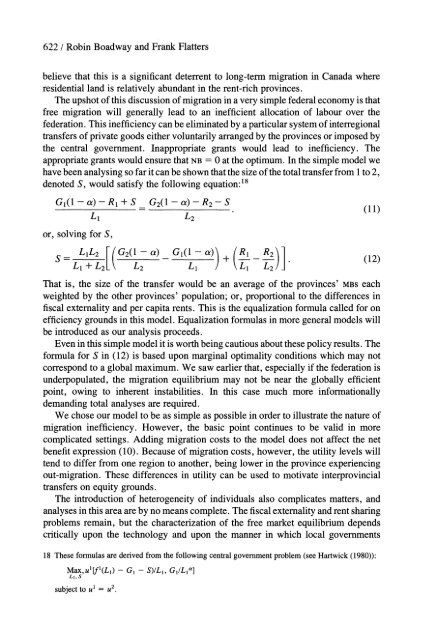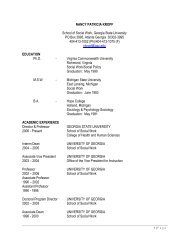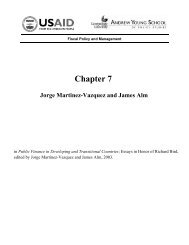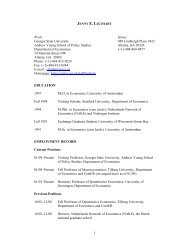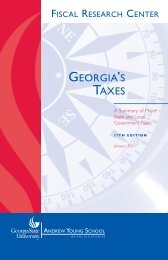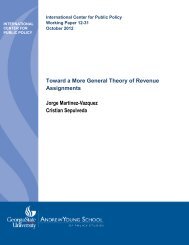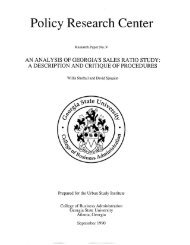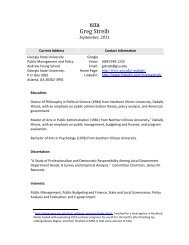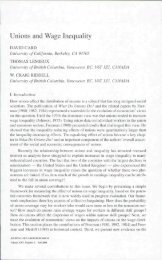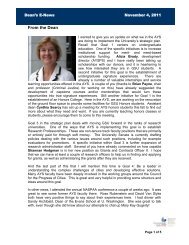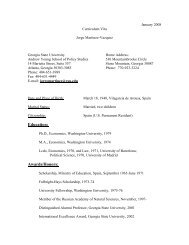Robin Boadway and Frank Flatters - Andrew Young School of Policy ...
Robin Boadway and Frank Flatters - Andrew Young School of Policy ...
Robin Boadway and Frank Flatters - Andrew Young School of Policy ...
Create successful ePaper yourself
Turn your PDF publications into a flip-book with our unique Google optimized e-Paper software.
622 / <strong>Robin</strong> <strong>Boadway</strong> <strong>and</strong> <strong>Frank</strong> <strong>Flatters</strong><br />
believe that this is a significant deterrent to long-term migration in Canada where<br />
residential l<strong>and</strong> is relatively abundant in the rent-rich provinces.<br />
The upshot <strong>of</strong> this discussion <strong>of</strong> migration in a very simple federal economy is that<br />
free migration will generally lead to an inefficient allocation <strong>of</strong> labour over the<br />
federation. This inefficiency can be eliminated by a particular system <strong>of</strong> interregional<br />
transfers <strong>of</strong> private goods either voluntarily arranged by the provinces or imposed by<br />
the central government. Inappropriate grants would lead to inefficiency. The<br />
appropriate grants would ensure that NB = 0 at the optimum. In the simple model we<br />
have been analysing so far it can be shown that the size <strong>of</strong> the total transfer from 1 to 2,<br />
denoted S, would satisfy the following equation:18<br />
Gl(l - a)- R1 + S G2(1 - a)- R2- S<br />
or, solving for S,<br />
L1 L2<br />
LIL2 (G2( 1 - a) Gi(l - a) (R R 2 ] (12)<br />
- L+L2 L1 L1 L2<br />
That is, the size <strong>of</strong> the transfer would be an average <strong>of</strong> the provinces' MBs each<br />
weighted by the other provinces' population; or, proportional to the differences in<br />
fiscal externality <strong>and</strong> per capita rents. This is the equalization formula called for on<br />
efficiency grounds in this model. Equalization formulas in more general models will<br />
be introduced as our analysis proceeds.<br />
Even in this simple model it is worth being cautious about these policy results. The<br />
formula for S in (12) is based upon marginal optimality conditions which may not<br />
correspond to a global maximum. We saw earlier that, especially if the federation is<br />
underpopulated, the migration equilibrium may not be near the globally efficient<br />
point, owing to inherent instabilities. In this case much more informationally<br />
dem<strong>and</strong>ing total analyses are required.<br />
We chose our model to be as simple as possible in order to illustrate the nature <strong>of</strong><br />
migration inefficiency. However, the basic point continues to be valid in more<br />
complicated settings. Adding migration costs to the model does not affect the net<br />
benefit expression (10). Because <strong>of</strong> migration costs, however, the utility levels will<br />
tend to differ from one region to another, being lower in the province experiencing<br />
out-migration. These differences in utility can be used to motivate interprovincial<br />
transfers on equity grounds.<br />
The introduction <strong>of</strong> heterogeneity <strong>of</strong> individuals also complicates matters, <strong>and</strong><br />
analyses in this area are by no means complete. The fiscal externality <strong>and</strong> rent sharing<br />
problems remain, but the characterization <strong>of</strong> the free market equilibrium depends<br />
critically upon the technology <strong>and</strong> upon the manner in which local governments<br />
18 These formulas are derived from the following central government problem (see Hartwick (1980)):<br />
Max,u[f(L1)<br />
subject to u' = u2.<br />
- G1 - S)/L1, Gi/L1a]


